Overview
A commercial real estate crash may be imminent, driven by elevated vacancy rates, rising interest rates, and notable price declines across various sectors, particularly in office spaces. These factors, coupled with inflated property valuations and cautious investor sentiment, create vulnerabilities that could precipitate a market downturn. Stakeholders must remain vigilant and engage in strategic planning to navigate these challenges effectively.
As vacancy rates climb, investors are increasingly concerned about the stability of their portfolios. Rising interest rates further exacerbate this uncertainty, making financing more expensive and potentially stalling new developments. The significant price declines observed in office spaces serve as a stark reminder of the shifting dynamics in the market.
In light of these trends, it is crucial for investors to reassess their strategies. By closely monitoring market indicators and adjusting their approaches, they can better position themselves to weather potential downturns. The implications of these developments underscore the need for proactive measures and informed decision-making in the face of evolving market conditions.
Introduction
The commercial real estate landscape in 2025 presents a complex tapestry woven from shifting demands, evolving tenant preferences, and economic pressures that are reshaping the industry. As remote work continues to influence office space utilization, the industrial sector is witnessing an unprecedented surge, driven by the booming e-commerce market. Amid these contrasting trends, the investment climate remains cautious, with rising interest rates prompting investors to reassess their strategies.
Opportunities in affordable housing and the adoption of artificial intelligence are emerging as key focal points for stakeholders navigating this intricate market. Understanding these dynamics is essential for identifying potential vulnerabilities and seizing growth opportunities in a sector that is both resilient and fraught with challenges.
Current Landscape of Commercial Real Estate: An Overview
The commercial real estate (CRE) sector in 2025 is navigating a multifaceted landscape marked by shifting demand, evolving tenant preferences, and significant economic pressures. Currently, vacancy rates in office spaces remain elevated, largely due to the enduring impact of remote work, which has fundamentally altered how businesses utilize physical space. In contrast, the industrial sector is experiencing robust demand, particularly for logistics and warehousing facilities, as e-commerce continues to thrive and supply chain efficiencies become paramount.
Digital economy assets are emerging as leading investment opportunities, reflecting the changing dynamics of the industry. Despite these contrasting trends, the overall investment climate is cautious, primarily influenced by rising interest rates that have tempered new developments. As a result, many investors are reassessing their strategies, focusing on properties that align with the digital economy and logistics needs. Notably, available retail space for lease has consistently remained below 5% over the past couple of years, indicating a tightening market in certain segments.
The demand for affordable housing presents a unique opportunity within the CRE landscape. Innovative financing solutions and public-private partnerships are being implemented to address the ongoing supply-demand imbalance in this sector. This trend underscores the potential for growth in affordable housing, which remains a critical need in many urban areas.
Furthermore, the integration of artificial intelligence (AI) in business property is gaining momentum, although still in its initial phase. A recent survey revealed that 76% of respondents are either researching or piloting AI solutions, primarily for enhancing accounting and financial planning processes. According to Deloitte, 'the advantages of AI implementation in business property are extensive, and automation can enhance decision-making procedures in the sector, making them more efficient and streamlined.' This technological shift is expected to improve operational efficiencies across the sector.
In summary, the present dynamics of the business property sector reflect a complex interplay of challenges and opportunities, raising concerns about a potential commercial real estate crash. Investors and stakeholders must stay alert, as understanding these trends is essential for identifying potential vulnerabilities that could lead to a commercial real estate crash.
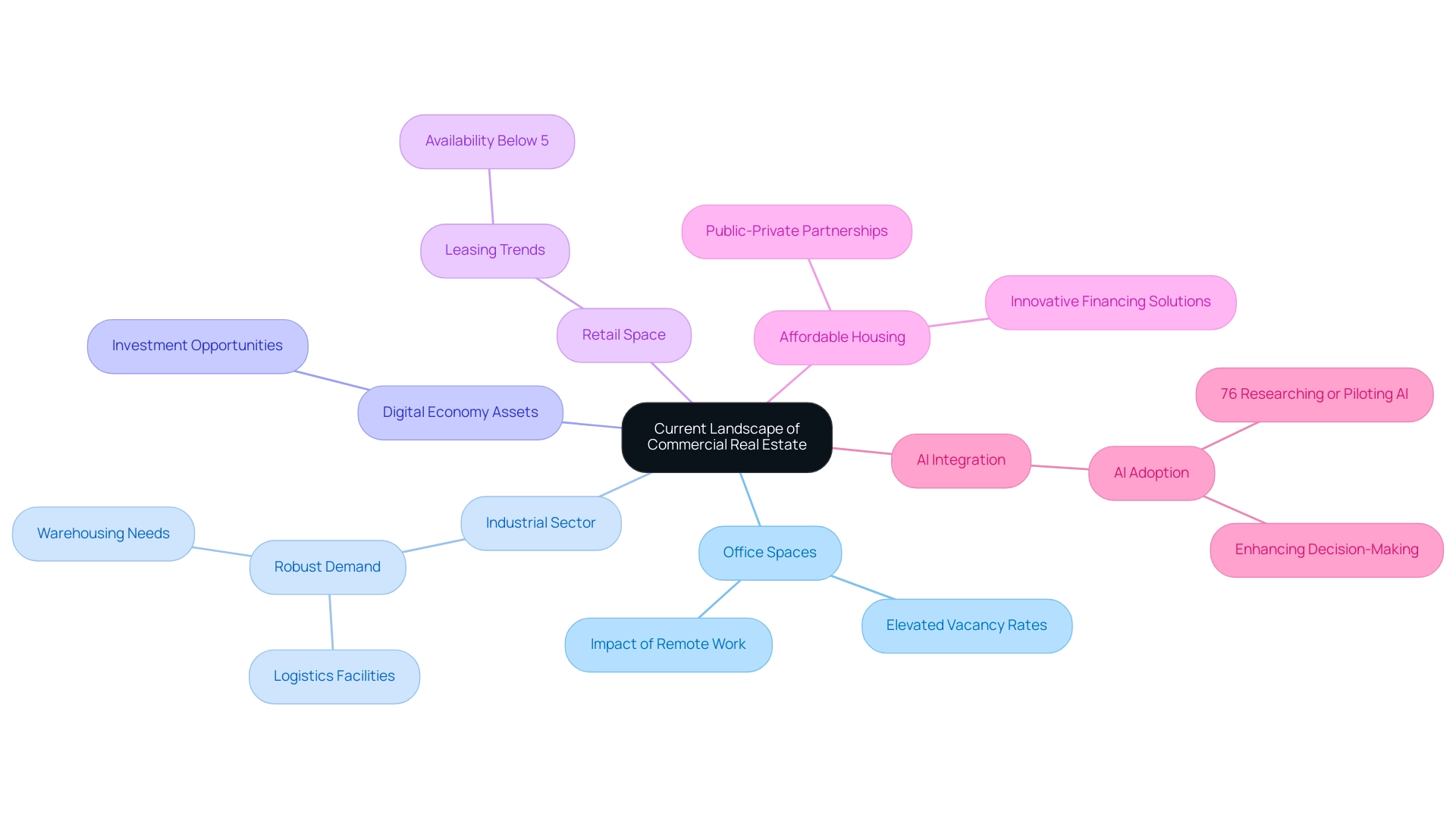
Stabilization Trends in Commercial Real Estate Markets
Amidst the challenges confronting the commercial property market, several significant stabilization trends are beginning to emerge. The industrial sector, in particular, is witnessing a notable resurgence, largely fueled by the surge in e-commerce. This shift has resulted in increased demand for distribution centers, as businesses strive to optimize their logistics and supply chains to meet consumer expectations.
Projections indicate that the industrial sector will continue to thrive, with opportunities for property owners and investors expected to expand over the next 12 to 18 months, particularly in digital economy properties, logistics, and warehousing facilities.
Urban office leasing is also showing signs of recovery, albeit gradually. As companies adapt to hybrid work models, there is a renewed interest in office spaces that can accommodate flexible working arrangements. This trend is particularly evident in urban areas where businesses are re-evaluating their property needs to foster collaboration while maintaining employee flexibility.
Moreover, the multifamily housing sector remains robust, driven by demographic shifts and a growing population. The demand for affordable housing continues to outpace supply, prompting innovative solutions such as public-private partnerships and modular construction to address the challenges posed by elevated construction costs and interest rates. The case study on affordable housing growth opportunities emphasizes how these collaborations are vital for creating affordable housing alternatives, ensuring that the sector can satisfy the needs of its inhabitants.
As highlighted by Deloitte, sustainability is becoming more integrated into the fundamental strategies of organizations, which is anticipated to yield long-term advantages in the changing business property environment.
In summary, while the business property landscape is filled with obstacles, these stabilization trends across various sectors offer a shield against a possible downturn. The resilience of the industrial sector, the gradual recovery of urban office leasing, and the ongoing strength of multifamily housing collectively suggest that certain segments of the market are adapting and evolving in response to current economic conditions. Additionally, with private lenders entering to address the funding gap as traditional banks lessen their exposure to business property loans, the current financing environment is becoming more dynamic, further increasing the importance of these stabilization trends.
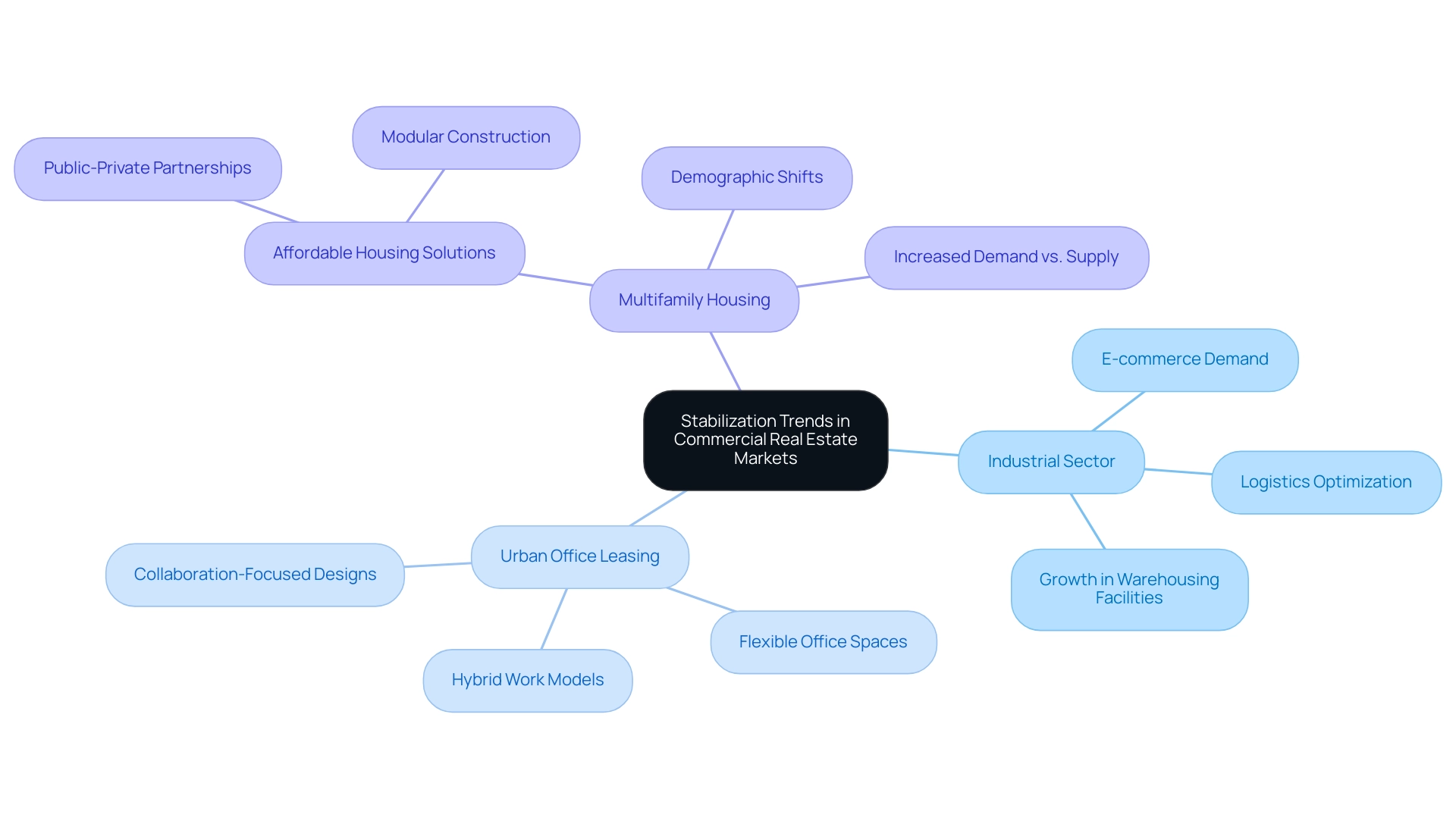
Price Declines: Indicators of a Potential Crisis
Recent data reveals a troubling trend of price declines across various sectors, indicating the potential for a commercial real estate crash. The CoStar Commercial Property Price Index, as of April 2025, shows a year-over-year decrease, highlighting a significant erosion of investor confidence coupled with tightening credit conditions. Particularly affected is the office space sector, where oversupply and reduced demand have led to substantial price reductions.
In January 2025, the real estate sector recorded a remarkable increase in transaction volume, amounting to $9.1 billion in repeat sales, a 34.6% rise compared to January 2024. However, the average sale-price-to-asking-price ratio fell to 93.1%, the lowest since November 2023. Chad Littell, national director of U.S. capital markets analytics for CoStar Group, noted, "That is the tightest this ratio has been since November 2023," indicating a market increasingly favoring buyers.
This decline in commercial property prices is not simply a statistical anomaly; it serves as a critical indicator of potential economic vulnerabilities that could precipitate a commercial real estate crash. The drop in distressed property sales, which constituted only 2.3% of total repeat-sale transactions in January 2025, reflects a shift in buyer interest and trading dynamics. Such trends often precede broader economic crises, signaling underlying financial weaknesses that, if unaddressed, could lead to a commercial real estate crash and a more severe downturn.
As investor confidence wanes, the implications for commercial property prices in the context of a potential crash become increasingly apparent, demanding close attention from industry stakeholders. Furthermore, the recent recovery in Downtown Nashville from a slowdown in multifamily construction exemplifies resilience in specific areas, underscoring the complexities within the broader trend of price declines.
As a leading authority in property information dissemination, Zero Flux remains committed to providing data-driven insights that empower industry professionals and investors to navigate these challenging conditions effectively.
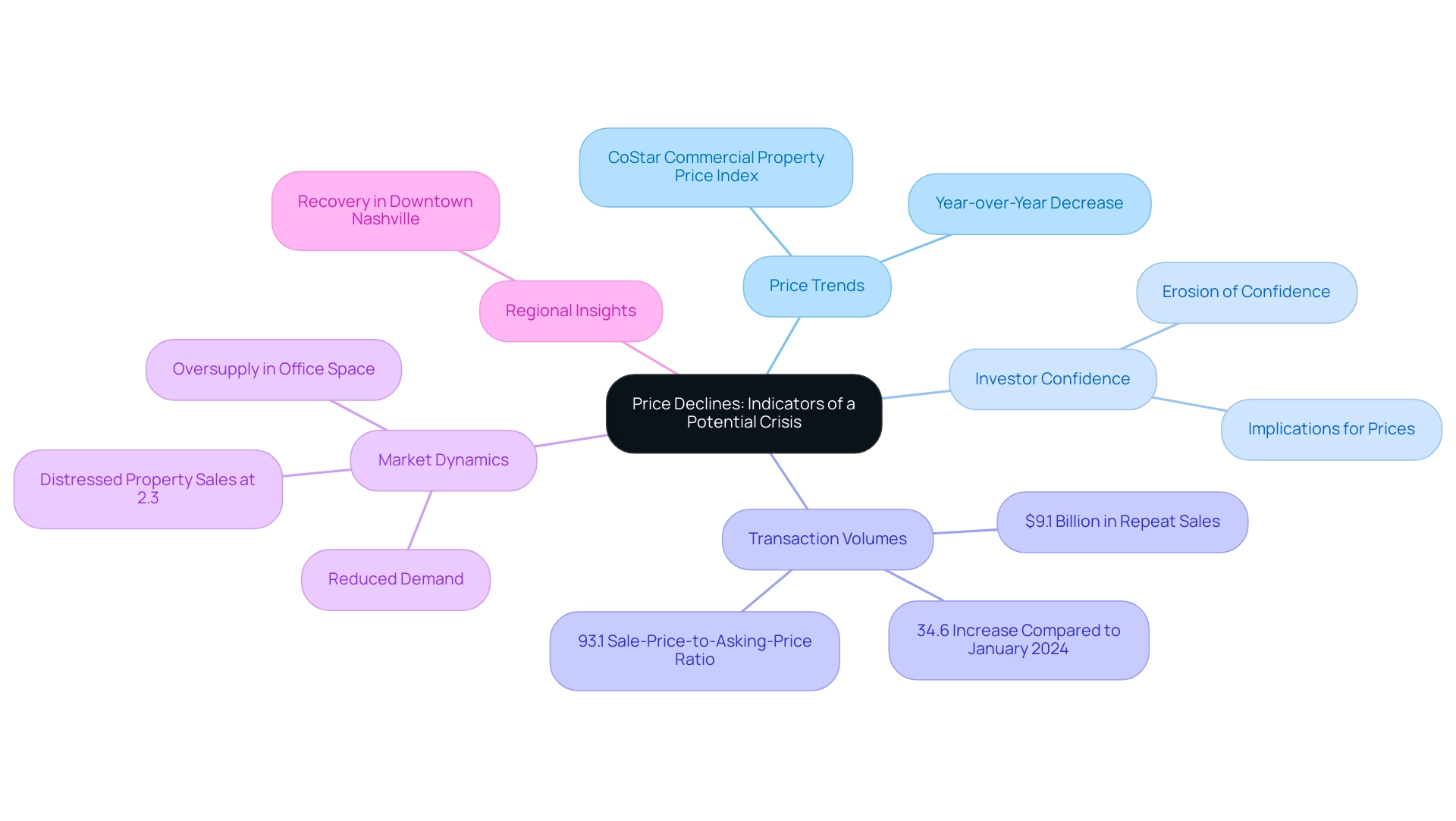
Assessing the Risk of a Financial Bubble in Commercial Real Estate
The commercial property sector is increasingly exhibiting signs indicative of a potential crash in commercial real estate. A major factor fueling this concern is the inflated property valuations, which have escalated due to speculative investments and historically low interest rates. As we approach early 2025, numerous properties are being valued at levels that may not be sustainable in the long term, raising alarms among industry experts.
The influx of capital into the sector, particularly from private equity and institutional investors, has further intensified these inflated valuations. This trend is underscored by the fact that:
- 37% of early-stage AI adopters in the real estate sector focus on accounting and reporting
- 43% of advanced adopters prioritize financial planning and analysis
This shift highlights a movement towards more data-driven investment strategies. However, this capital influx may foster an environment increasingly susceptible to a commercial real estate crash.
Indicators of a commercial real estate crash are becoming more pronounced. For instance, Northspyre's analysis suggests that while a recovery in the CRE sector is anticipated for 2025—driven by interest rate cuts and improved investment activity—the multifamily and industrial sectors are likely to spearhead this recovery. This sentiment underscores the precarious balance that the system currently faces.
Moreover, the potential for economic shifts—such as rising interest rates or a slowdown in economic growth—could trigger significant repercussions for the economy. Investors are advised to focus on high-quality assets and remain prepared for ongoing volatility, as the landscape is fraught with uncertainty. In fact, housing starts increased by 11.2% in February to 1.5 million units, propelled by single-family construction, indicating a potential rise in activity that could impact the CRE landscape.
In light of these developments, the sector must navigate the challenges posed by inflated valuations and the looming threat of a commercial real estate crash. The present environment demands vigilance and strategic planning to mitigate risks and seize emerging opportunities, particularly in areas such as digital economy properties, logistics, and warehousing, which are expected to be leading prospects for property owners and investors over the next 12 to 18 months.
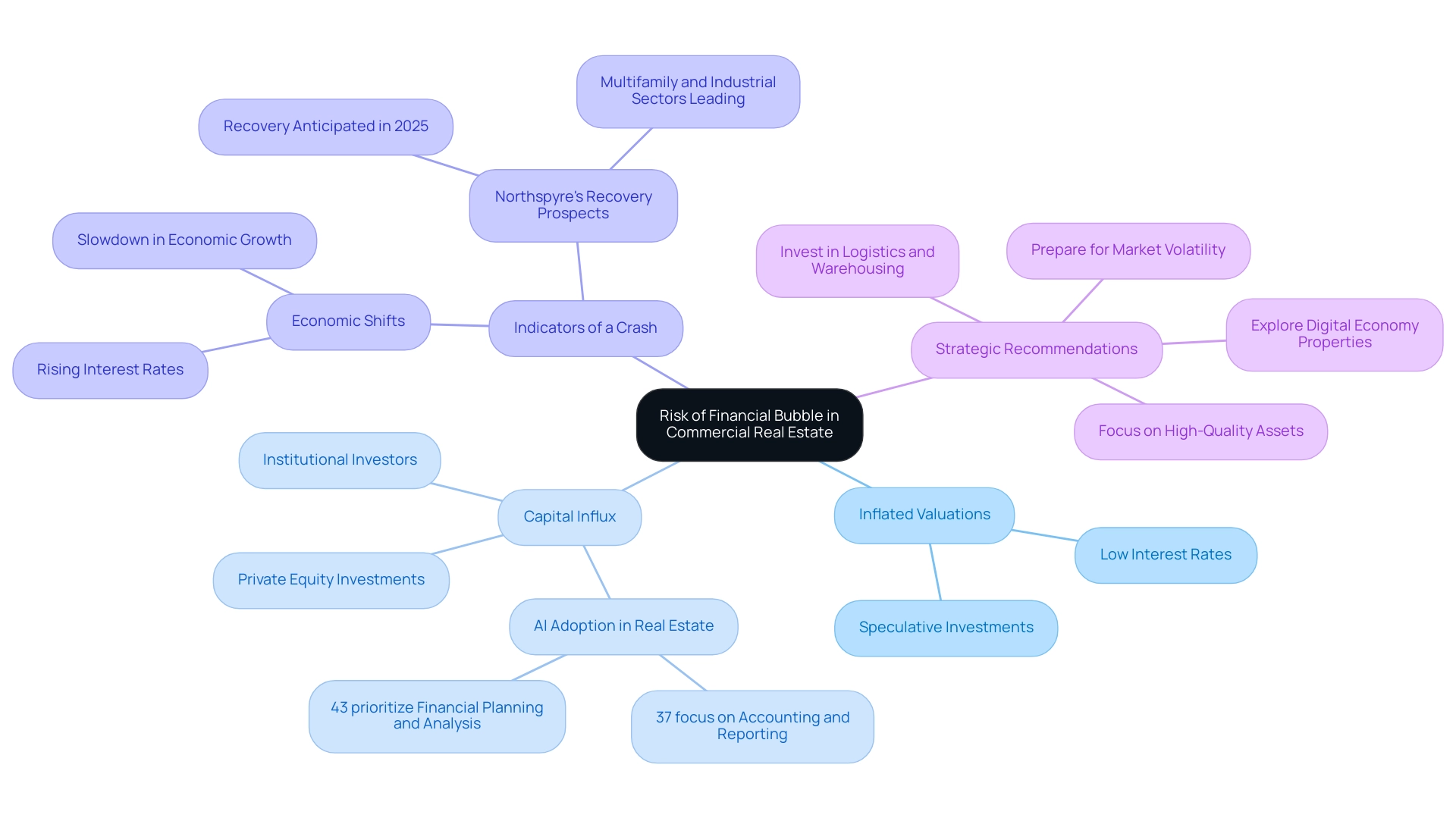
The Impact of Rising Interest Rates on Commercial Real Estate
Increasing interest rates present a significant challenge to the commercial property sector, potentially triggering a commercial real estate crash by elevating borrowing costs and diminishing the affordability of new investments. As the Federal Reserve continues to adjust interest rates in response to ongoing inflationary pressures, investors must reassess their strategies. The current economic climate, shaped by over $10 trillion in post-Covid fiscal and monetary stimulus, creates a complex landscape that heightens concerns about a potential commercial real estate crash, which could lead to diminished property valuations.
Potential buyers may find it increasingly difficult to secure financing on favorable terms, which could deter new acquisitions. This shift in economic dynamics not only impacts prospective buyers but also places current property owners in a vulnerable position due to the imminent threat of a commercial real estate crash. Many face refinancing hurdles as their existing loans mature, which may exacerbate financial strain and contribute to rising vacancy rates during a commercial real estate downturn. For example, ongoing political uncertainty and its ramifications for the economy have rendered the real estate sector especially susceptible to interest rate fluctuations, potentially culminating in a commercial real estate crash.
Experts warn that developments such as possible new tariffs and tax cuts could further escalate construction costs, complicating the response to these challenges. However, Washington, DC remains the most sought-after US rental market in 2025, with a 7% increase in favored listings, signaling sustained demand for rental properties even amid rising interest rates. Insights from industry leaders suggest that while the short-term outlook may seem daunting, there is cautious optimism for a resurgence in business transaction activity. As David Link, EVP and regional managing director, notes, "Freddie Mac and Fannie Mae are expected to remain active in multifamily lending," which may offer some stability within the sector.
Moreover, robust public-private partnerships are essential for affordable housing development, with government support available for private developers. Nevertheless, the overarching trend of rising borrowing costs continues to loom large, necessitating a strategic approach for investors navigating this evolving landscape, particularly to mitigate the risks associated with a potential commercial real estate crash.
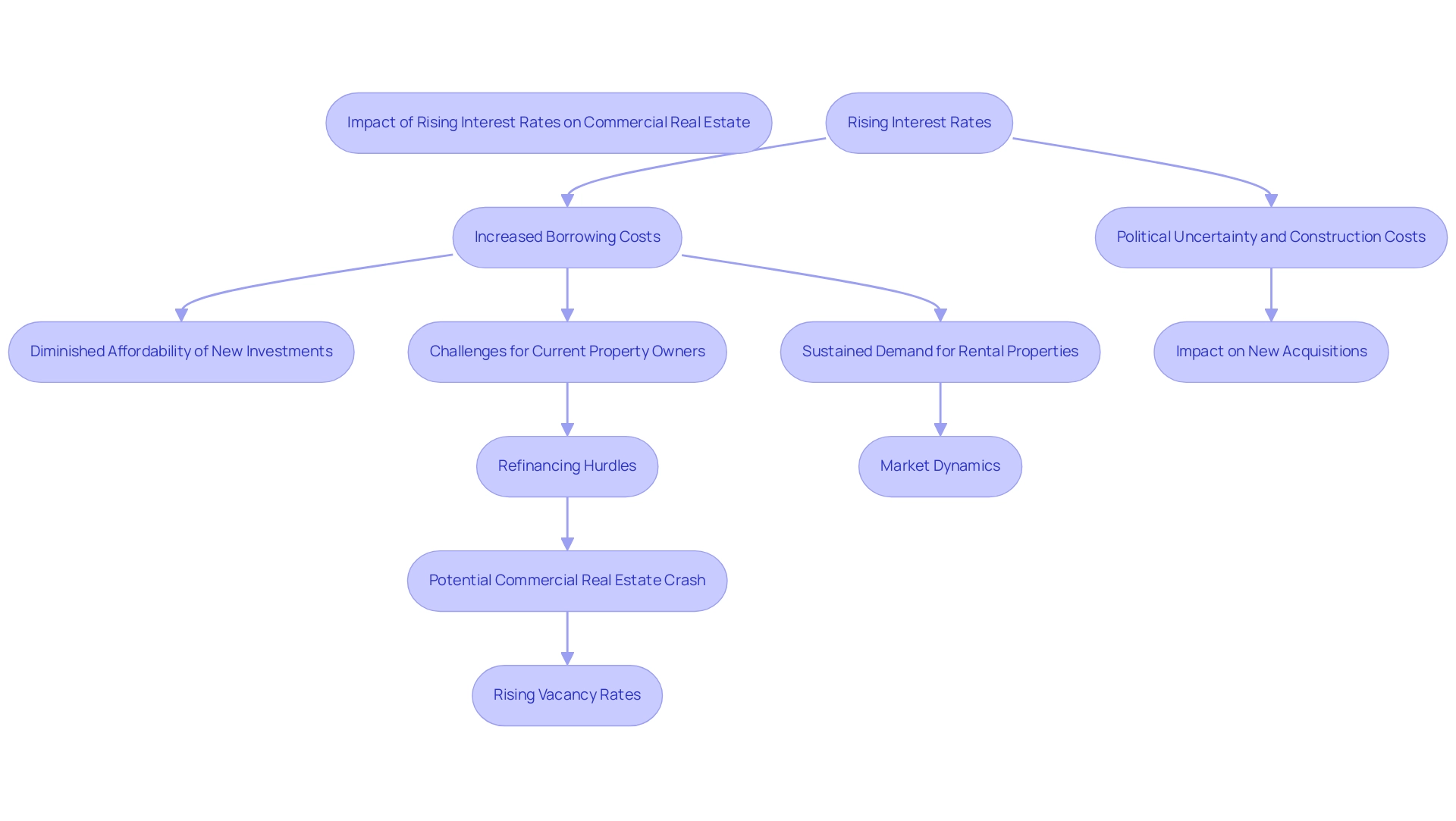
Expert Predictions: Is a Commercial Real Estate Crash Imminent?
The outlook for the commercial real estate sector in 2025 presents a complex picture, particularly amid concerns regarding a potential crash. Experts express a spectrum of opinions on this matter. Some analysts anticipate a gradual recovery, driven by signs of returning liquidity and a positive shift in sentiment among industry professionals. Recent surveys reveal that 88% of respondents intend to leverage digital technologies to enhance performance over the next 12 to 18 months. This proactive approach suggests a readiness to navigate existing challenges.
However, caution remains a prevalent theme. High vacancy rates, rising interest rates, and the looming potential for economic downturns cast shadows over the possibility of a commercial real estate crash. A significant portion of industry professionals perceives the environment as unstable, particularly due to these concerns, advocating for careful investment strategies.
This mixed sentiment is further illustrated by ongoing growth in the private credit sector, where large asset managers are successfully raising substantial funds. As Peter Fisch notes, "Private credit seems to be booming, and many of the largest asset managers are raising huge sums into private credit." Clients are increasingly turning to private credit sources, although many prefer to maintain existing lending relationships, indicating a cautious approach to financing.
Moreover, the adoption of artificial intelligence in commercial real estate remains in its infancy. Notably, 76% of survey respondents are either researching or piloting AI solutions, primarily for accounting and financial planning. This technological shift could play a crucial role in shaping the future landscape of the industry.
As we progress deeper into 2025, the significance of closely observing economic indicators cannot be overstated. The potential for rapid changes in the economic environment necessitates a vigilant approach to investment. It is essential for stakeholders to stay informed and adaptable in the face of uncertainty. The positive shift in sentiment regarding property prospects, alongside existing challenges, underscores the necessity for a balanced viewpoint as the sector continues to evolve.
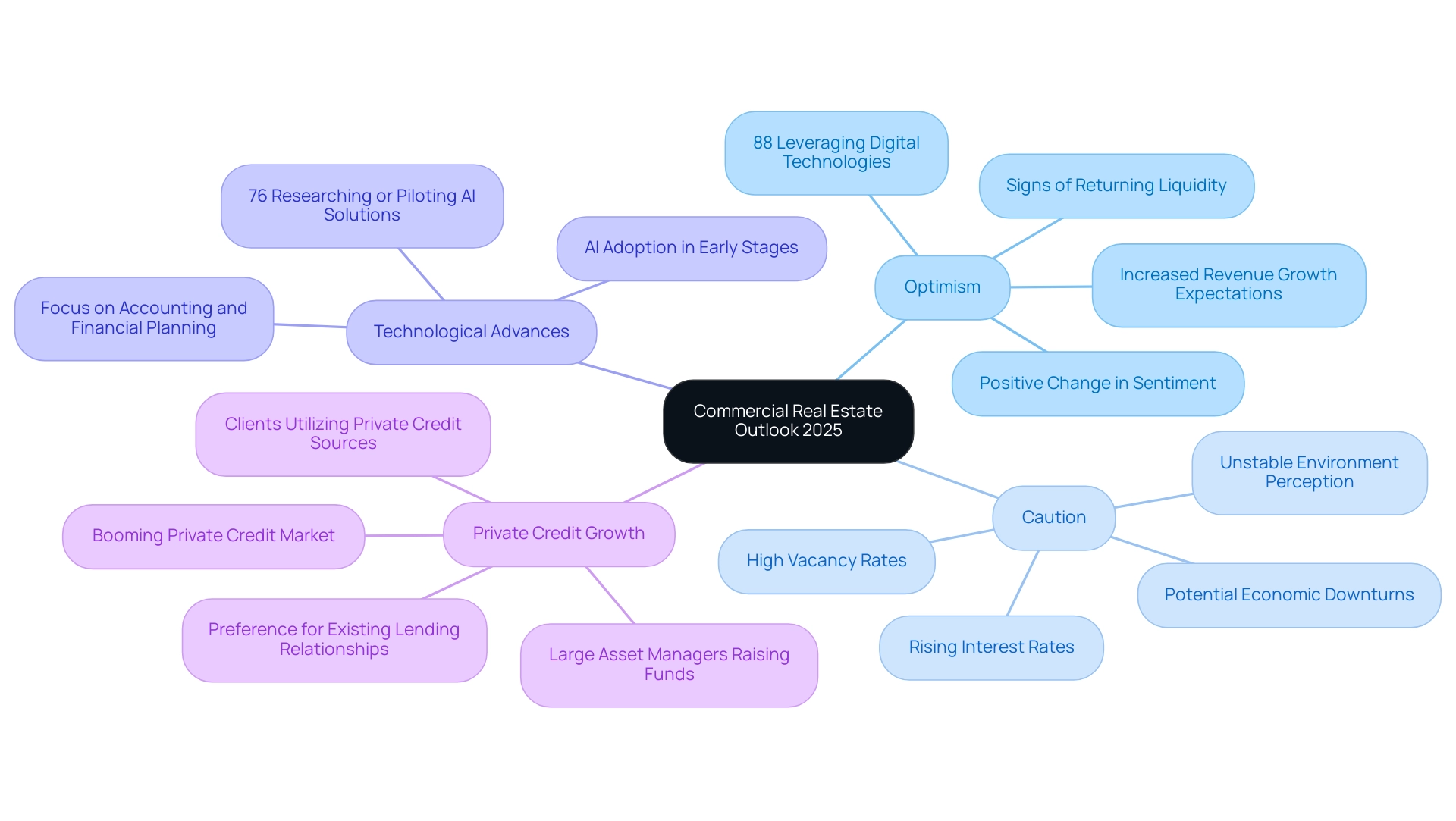
Navigating the Market: Strategies for Investors Amid Uncertainty
In light of the current uncertainties in the commercial real estate sector, the impending commercial real estate crash necessitates that investors adopt a proactive approach to effectively navigate potential challenges. A pivotal strategy involves diversifying investment portfolios across various asset classes, significantly mitigating risks associated with volatility. Notably, as of 2025, a substantial 70% of North American respondents anticipate engaging in deep energy retrofits within the next 12 to 18 months. This trend indicates a shift towards sustainability, which can enhance property value and appeal.
Another essential tactic is to focus on properties with robust cash flow potential. Investors should prioritize assets that exhibit resilience in fluctuating economic conditions, ensuring a steady income stream even during downturns. Conducting thorough due diligence on fundamentals—such as occupancy rates, local economic indicators, and tenant stability—remains paramount for making informed investment decisions.
Moreover, staying informed about macroeconomic trends and regulatory changes can provide a competitive advantage. For instance, the growing acceptance of Building Performance Standards across several U.S. states and cities by the end of 2024 presents unique opportunities for deep energy retrofits, enhancing property performance and attracting environmentally conscious tenants. Additionally, emerging financing options like green bonds and sustainability-linked bonds are increasingly relevant for investors aiming to support sustainability initiatives within their portfolios.
As Cheema aptly noted, "Persistence, likening success to the stonecutter’s creed: consistent effort eventually yields results." This mindset is crucial for investors navigating the complexities of the commercial real estate sector amid the potential for a commercial real estate crash.
Case studies reveal that optimism varies significantly across regions; respondents from North America and Asia Pacific express greater confidence in improved leasing conditions compared to their European counterparts, who are more reserved in their outlook. This disparity underscores the importance of regional insights in shaping investment strategies. By implementing these approaches, investors can better position themselves to navigate market fluctuations and capitalize on emerging opportunities, all while adhering to Zero Flux's commitment to data integrity and sourcing information from credible outlets.
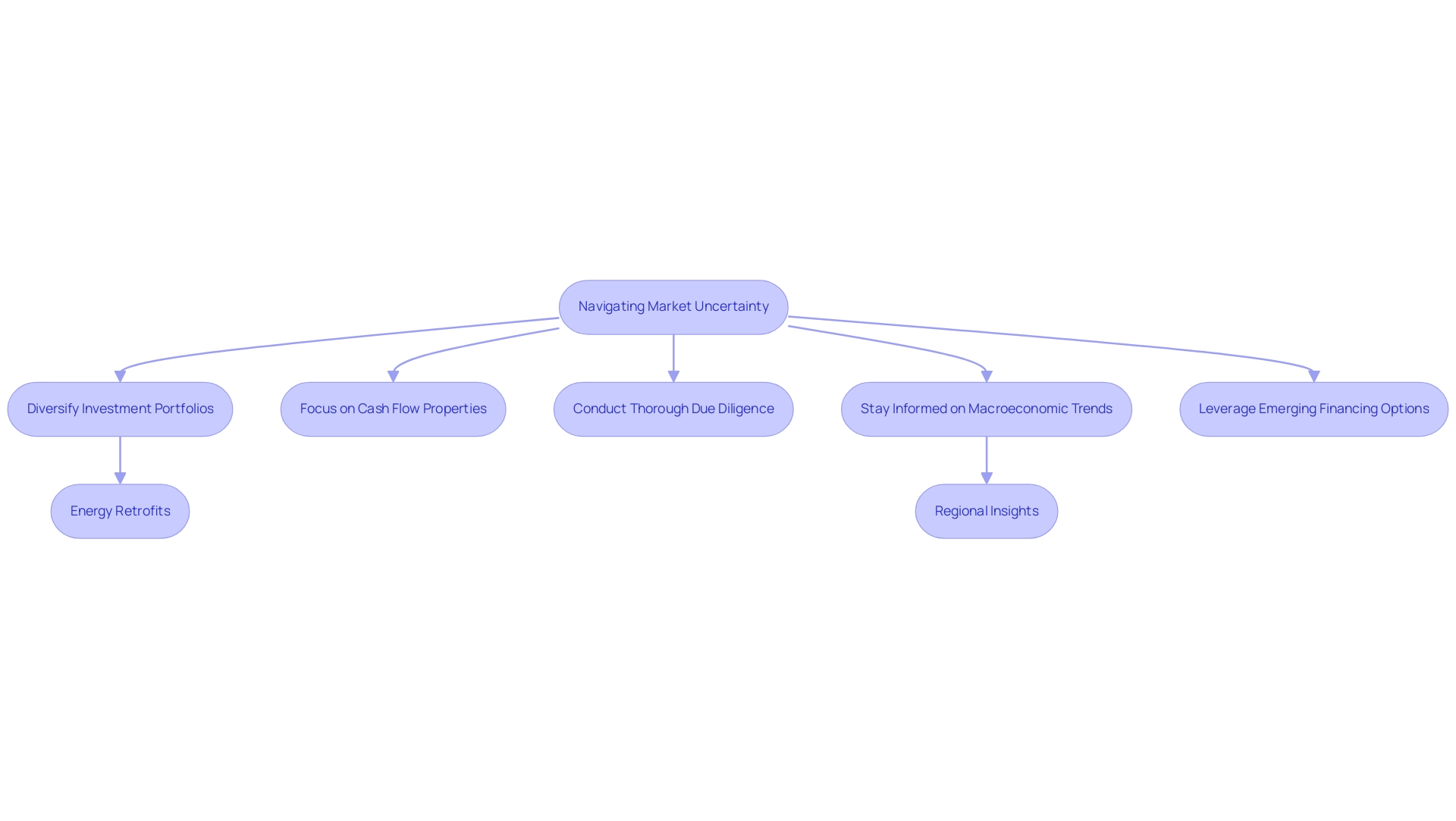
Conclusion
The commercial real estate market in 2025 presents a complex interplay of challenges and opportunities that stakeholders must navigate with precision. The ongoing impact of remote work has resulted in elevated vacancy rates in office spaces, yet the industrial sector flourishes, driven by the e-commerce boom. Investors are recalibrating their strategies in response to rising interest rates and shifting demands, placing emphasis on digital economy properties and affordable housing solutions.
While some sectors, such as urban office leasing and multifamily housing, show signs of stabilization, concerning trends persist, including price declines and the looming threat of a financial bubble. These developments underscore the critical need for vigilance and strategic planning, as the market remains vulnerable to economic fluctuations. Moreover, the adoption of artificial intelligence and sustainable practices is emerging as a potential game-changer, paving the way for enhanced efficiency and resilience.
Ultimately, investors are strongly advised to diversify their portfolios, prioritize properties with robust cash flow, and remain attuned to macroeconomic trends. By embracing a proactive and informed approach, stakeholders can better position themselves to navigate the uncertainties of the commercial real estate landscape and seize emerging opportunities. Although the future may be fraught with challenges, careful strategy and adaptability can unlock the potential for growth and stability.

